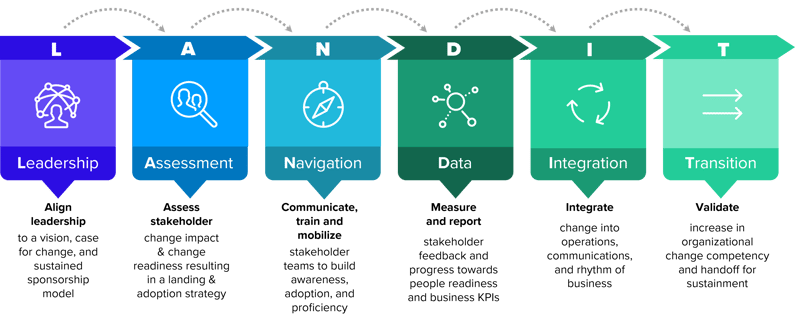Effective change management execution is essential to prepare and equip people across your organization to successfully adopt a transformation at any scale. Addressing a select number of areas across a business, traditional change management efforts don’t always fulfill transformation end to end, which is why we’ve adapted our own approach to change management. Called ‘Landing and Adoption Readiness (L&AR),’ our flexible, nimble, and pragmatic methodology prioritizes people readiness.
Our time-tested, proven change management principles have served as a basis for our efforts in cultivating transformation success for leading companies across a wide range of industries. We’re sharing our insights and methodology in a two-part blog series. In our first post, we covered why it’s essential to place an emphasis on your organization’s people in transformation and change initiatives.
In our second and final post in this series, we will reveal our own change management framework, and how you can apply our best practices to your next transformation initiative.
The LAND-IT methodology
Our experience in leading client business transformations is the basis for our L&AR methodology, which we call LAND-IT. This methodology integrates change management best practices, a humanistic approach, and design thinking with a pragmatic emphasis on building adoption, proficiency, and utilization.
LAND-IT methodology

Let’s look at the purpose of each phase in our LAND-IT methodology and the key outcomes that will ensure you achieve the goals of your business transformation efforts:
Leadership
Purpose: The first element of our ‘LAND-IT’ methodology is leadership. The goal of leadership as it pertains to our methodology is to build alignment on the vision for change and the sense of urgency for that change. Tactically, this first phase requires you to define a sponsorship coalition among leaders of an organization. The leadership phase provides you with the time and resources you need to later build a clear framework for executing the transition. Leadership alignment is critical in cultivating effective transformations. In fact, Prosci identifies sustained and visible leadership as the most important success factor in leading change.
Key outcomes for this phase include:
- A unified vision
- A focused sense of urgency
- Sponsorship alignment
Assessment
Purpose: The second element of the LAND-IT methodology requires performing an assessment. An assessment will help you determine the areas of your organization that you will need to prioritize and focus on as you build out your change management strategy. Specifically, you should evaluate the change impact, readiness, and resistance risks for stakeholder groups including internal and external teams. With the assessment results and framework you built in the leadership phase, you will be able to define a holistic landing and adoption strategy that will allow you to direct the implementation of project initiatives.
Key outcomes for this phase include:
- An understanding of the change’s impact and potential resistance across your organization’s people (including partners, distributors, vendors, and end customers)
- The formation of an integrated, holistic change management plan
Navigation
Purpose: The third element is navigation. The goal of the navigation phase is to build awareness and readiness among your stakeholders. The navigation phase requires you to deploy sustained audience-focused communications, training, and other mobilization programs within your organization. The resources you build will help promote change adoption, a proficient adaption to the organizational shift and transition, as well as utilization of updated processes, systems, and tools.
Key outcomes for this phase include:
- The awareness, engagement, and adoption of the widespread change
- The proficiency and utilization of new and updated tools, systems, workflows, and business processes
Data
Purpose: The fourth phase—data—focuses on defining, measuring, and reporting stakeholder readiness progress towards people readiness objectives. The goal of collecting and reporting data within the LAND-IT methodology is to determine where you stand in terms of readying your organization for transformation. Tracking your people readiness impact on business key performance indicators (KPIs) and stakeholder feedback will give the needed insight to create and adjust transformation project initiatives.
Key outcomes for this phase include:
- Complete visibility to people readiness KPIs
- The articulation of the change’s full business impact
- An ability to adjust and improve where needed
Integration
Purpose: The integration stage requires fulfilling the adoption of a new experience, process, system, and/or tool(s) among your organization’s internal and external stakeholders. The goal of integration within the LAND-IT methodology is to incorporate the actual change or innovation into your business operations. Ongoing organizational communications, practices such as annual planning and incentives, as well as business forums, should align with the new ways of working.
Key outcomes for this phase include:
- The integration of the change into organizational operations such as business planning, ongoing communications, and employee/partner programs
- Sustainment of the adoption and utilization results
Transition
Purpose: Finally, the transition phase is meant to nurture your transformation. The goal of the transition phase is to validate the change in terms of organization competency and maturity. This stage will also reveal findings and lessons that will help you determine the best paths for moving forward. Plans of action and final communication will help you prepare for the complete transition within your operations and pave the way for sustained progress.
Key outcomes for this phase include:
- Increased organizational change competency
- A smooth handover for long-term sustainment
People readiness is the key to building sustained success
Fulfilling proactive innovation and transformation requires a careful orchestration of strategy, technology, business processes, and support for your organization’s people. Since the first three elements are much more visible and tangible, it’s easy for leaders and managers to lose focus on the last one – their people.
To successfully integrate new innovations and transformation and maximize return on these investments, leaders need to intentionally prepare their teams, partners, and customers to adopt and embrace new ways of working. At Spur Reply, we believe the most successful initiatives place an emphasis on effective people readiness. The building of adoption, proficiency, and utilization is key to achieving business objectives, gaining ROI, and meeting long-term goals.
Spur Reply has the skills and expertise to work alongside your teams to successfully land your transformations and innovations across your ecosystem. To discover how we’ve partnered with leading companies to successfully land their transformations and innovations, assess the business risks of your own people readiness, and learn how to integrate a progressive approach to change management (specifically through L&AR) into your business operations framework, check out our guide on leading organizational change.
If you want to find out more about how we can partner with you to execute your next business transformation or organizational change, reach out here.
This blog is the second post in a two-part series on best practices in change management. Check out the first post on why it’s essential to place an emphasis on your organization’s people in transformation and change initiatives.

